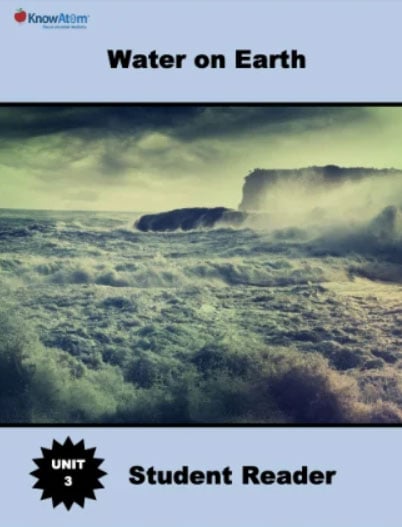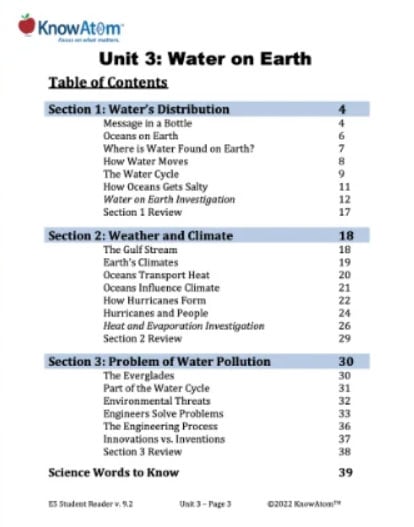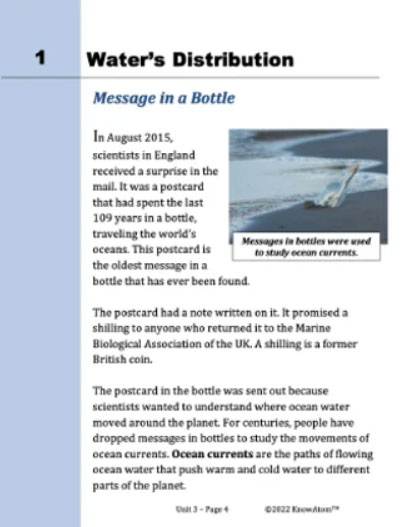Once students understand how the hydrosphere is made up of different parts, they figure out how heat affects the phenomena of evaporation rate of water, and then analyze how Earth’s atmosphere and hydrosphere interact during a hurricane.
In this unit, students analyze the science phenomena of the important role that oceans play in regulating Earth’s climate. In this lesson, they focus on how oceans interact with other Earth systems to distribute water and heat around the planet, resulting in various weather patterns, including hurricanes. This page highlights key components of this lesson.
The science background section provides teachers with more in-depth information about the phenomena students explore in this unit. Below is an excerpt from the science background information on Earth’s interacting systems.
Water interacts with the biosphere, which is made up of all living things on Earth. All living things need water to survive. Plants absorb water through their roots and release it through their leaves as water vapor back to the atmosphere. The process by which water moves through plants from roots to their leaves and then evaporates is called transpiration.
Plants can also access groundwater if their roots are deep enough to reach the water table—the highest point in an aquifer from which water can be obtained.
Water that doesn’t seep into the ground or get absorbed by plants and animals flows downhill because of gravity. Any area of land where all of the water that falls in it drains into a common outlet is called a watershed. The watershed is made up of all of the surface water, including lakes, streams, reservoirs, and wetlands, as well as all the underlying groundwater. Larger watersheds contain many smaller watersheds.
The circulation of water through the hydrosphere from Earth’s surface to the atmosphere and back is called the water cycle. The water cycle is complex, and its processes vary around the planet. For example, very deep groundwater can take more than a million years to complete the water cycle and return to the ocean. In contrast, in hot climates and seasons, precipitation sometimes evaporates just seconds after it falls to Earth’s surface.
The water cycle is a major contributor to weather and climate around the planet. Climate is the average weather over a span of 30 years. Weather refers to the conditions of the atmosphere (temperature, humidity, wind speed, air pressure, and precipitation) in a particular place at a particular time. Weather changes hour-to-hour, while climate changes over long periods of time.
A location’s climate is determined by its proximity to the ocean, its elevation, and its proximity to the equator. Regions of the United States that are at low elevations, are close to the equator, and close to the ocean tend to have a wetter and warmer climate. Regions that are at higher elevations, are farther away from the ocean, and farther from the equator tend to be cooler and drier.
The Everglades have a tropical climate because of their location near the equator. Remember that Earth is a sphere. Around the equator, the sun’s rays shine directly onto the planet. This equatorial region is the tropical climate zone. The sun’s rays are the most concentrated here, which causes temperatures to be high.
Moving north or south of the equator, the sun’s rays are spread over a larger area. This causes Earth’s surface north and south of the equator to receive less direct heat from the sun. As a result, these regions have lower temperatures.
Earth’s land, oceans, and atmosphere all absorb heat from the sun, but the oceans absorb the most. This means that the tropical waters around the equator absorb the most heat.
Ocean currents also transport warm water and precipitation from the equator toward the North and South poles, and cold water from the poles back to the tropical region. The Gulf Stream is one ocean current that flows eastward from the Gulf of Mexico, around the southern tip of Florida, and along the East Coast up to Iceland and Norway. Scientists first discovered the origin of the Gulf Stream in the mid-1800s by setting adrift bottles and monitoring where they traveled. Benjamin Franklin was the first to chart its path in the 1700s.
As water moves through the water cycle, it connects all of Earth’s systems. For example, the movement of water downhill on Earth’s surface is the largest source of weathering and erosion on the planet. It is also the reason that oceans are salty. Oceans are salty because of interactions between the hydrosphere, the geosphere (Earth’s landforms, including rocks and soil), and the atmosphere (the mixture of gasses, dust, water vapor, and other molecules above Earth’s crust).
One of the gasses in the atmosphere is carbon dioxide. When water falls to Earth’s surface as rain, it carries some of this carbon dioxide, making the water slightly acidic. This slightly acidic water causes chemical weathering of the rocks on Earth’s surface, an interaction between the geosphere and the hydrosphere. The chemical weathering breaks down the rocks, transforming the matter into new substances with different properties, including salt and other minerals.
All water that collects on Earth’s surface will eventually flow downhill because of the pull of Earth’s gravity. As water flows downhill, it erodes the particles of salt and other weathered matter. All water eventually ends up in the ocean, where it deposits the salt and other matter. Over millions of years, this salt has collected in the oceans, creating the salt water of the oceans.
Once students understand how the hydrosphere is made up of different parts, they figure out how heat affects the phenomena of evaporation rate of water, and then analyze how Earth’s atmosphere and hydrosphere interact during a hurricane.

Prepared hands-on materials, full year grade-specific curriculum, and personalized live professional development designed to support mastery of current state science standards.
Climate : the average weather over a span of 30 years
Evaporation : the process of liquid water changing into water vapor, its gas state
Hurricane : a storm system with strong thunderstorms and sustained winds of 119 to more than 252 kilometers per hour
Ocean Currents : paths of flowing ocean water that push warm and cold water to different parts of the planet
Precipitation : the process of water falling back to Earth in the form of rain, snow, sleet, or hail
Proportion : the relationship between things, as to size, quantity, or number
Water Cycle : the circulation of water through the hydrosphere from Earth’s surface to the atmosphere and back
Weather : the conditions of the atmosphere (temperature, humidity, wind speed, air pressure, and precipitation) in a particular place at a particular time
Oceans Transport Heat
Earth’s land, oceans, and atmosphere all absorb heat from the sun. But the oceans absorb the most. This means that the tropical waters around the equator absorb the most heat.
As the ocean absorbs sunlight, its surface warms. With enough heat, the water moves into the atmosphere as water vapor. Evaporation increases the temperature and humidity of the surrounding air. This then causes rain and storms that are carried by winds around the planet. The water cycle is very influenced by these interactions between the atmosphere and the ocean. In fact, the ocean is the primary source of the water cycle. 78 percent of all rain falls onto the ocean and 86 percent of all water evaporation comes from the ocean.
Ocean currents also carry warm water and precipitation from the equator toward the North and South poles. They carry cold water from the poles back to the tropical region.


Oceans Influence Climate
As they absorb heat and transfer it and water around the planet, oceans influence Earth’s weather and climate. Weather refers to the conditions of the atmosphere (temperature, humidity, wind speed, air pressure, and precipitation) in a particular place at a particular time. Climate is the average weather over a span of 30 years. Weather changes hour-to-hour. Climate changes over very long periods of time.
Global Ocean Surface Temperatures
How close a region is to the equator affects its climate. So does its nearness to the ocean and its elevation. Because tropical regions receive the most direct sunlight, they also experience the most rainfall. This rainfall is mostly over the oceans. They also tend to have a wetter and warmer climate. Regions that are at higher elevations, are farther away from the ocean, and farther from the equator tend to be cooler and drier.

How Hurricanes Form
As oceans interact with the atmosphere, they cause weather events. For example, a hurricane is a storm system with strong thunderstorms and sustained winds of 119 to more than 252 kilometers per hour (km/h).
Hurricanes form when ocean water is hot enough to quickly evaporate into water vapor and condense into large clouds. Because of this, hurricanes always begin over warm ocean water near the equator. Hurricanes are then moved by global winds called trade winds that push them from east to west. Trade winds push hurricanes from east to west.
Hurricanes begin when evaporation makes the air above the ocean humid and warm. Humidity is a measure of the amount of water vapor in the air compared to how much water vapor the air can hold. A 0 percent relative humidity means that there is no water vapor in the air. When relative humidity is 100 percent, the atmosphere is full of water vapor. Some is released as precipitation.
As evaporation makes the air warmer, that warmer air rises in the atmosphere. At the same time, cold air sinks, creating wind. Winds coming together force air upwards. As humid air rises, it creates clouds. Winds from outside the hurricane push the storm from east to west. Hurricanes can grow more than 800 kilometers wide, with winds more than 252 km/h. They grow stronger when there is warm, moist air. When a hurricane reaches land or cooler water, it weakens because it has no more water or heat to fuel its growth.
In this lesson, students first analyze how heat affects the evaporation rate of water, and then develop a model to figure out and describe how Earth’s atmosphere and hydrosphere interact to form phenomena called a hurricane. In the first part, students collect and analyze data on the evaporation rate of water over time compared to water in cool locations. Students use information from both investigations to analyze how heat drives the water cycle, which in turn fuels the formation of hurricanes.
KnowAtom incorporates formative and summative assessments designed to make students thinking visible for deeper student-centered learning.

Standards citation: NGSS Lead States. 2013. Next Generation Science Standards: For States, By States. Washington, DC: The National Academies Press. Neither WestEd nor the lead states and partners that developed the Next Generation Science Standards were involved in the production of this product, and do not endorse it.
